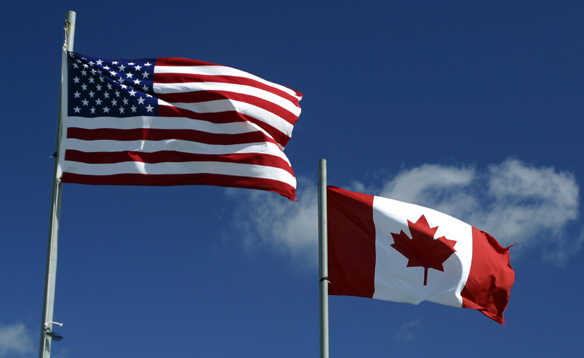In light of US Consul General Jim Dickmeyer’s talk on North American security this week at the National Club, it is an excellent time to discuss the bilateral security relationship that Canada and the United States have been pursuing since 2001. In the wake of 9/11, the cooperation between our two nations at curbing common North American security threats has expanded significantly, and has taken many forms over the past decade. In particular, the border between the two countries has evolved to a state that would have been unimaginable ten years ago. Concurrently, the economic relationship between Canada and the United States has continued to grow, undeniably making the continued facilitation of trade an important variable in the equation of how to oversee a border that balances security and economic accessibility.
The first major post-9/11 change to the Canada-US border came just a few months after the attacks, in which the Canadian and American governments worked together to create the Action Plan for Creating a Secure and Smart Border. The Plan places emphasis on four major pillars, all of which have remained major areas of emphasis in the current day. The first two pillars emphasized the need for a secure flow of people and goods, while the third called for a modernizing of the border infrastructure. The final pillar called for the latter three to be organized transparently between the two governments. While this did foster the beginning of a new host of programs concerning border security, including integrated border enforcement teams from Canada and the United States which continue to work together, it created a large amount of bureaucracy and led to a thickening of the border that hampered trade.
The second major attempt at increased border security came in 2005, this time at a continental level, with the Security and Prosperity Partnership (SPP). This initiative was aimed at developing a trilateral partnership between Canada, Mexico and the United States on economic and security related issues, in which policies and regulations were liberalized. Various summits were organized in which senior policy makers from all three countries would meet to discuss common issues. While it was an evolution of what had begun with the Secure and Smart Border plan, it did come to experience challenges in accomplishing its mandate. The more stable environment of the Canada-US border was and continues to be quite distinct from the more volatile and militarized US-Mexico border, and the SPP illuminated these differences, highlighting the need for distinct policies for the two borders. Thus, as the SPP continued, the United States began a policy of dual-bilateralism as opposed to trilateralism, working unilaterally with Canada and Mexico individually. This plan collapsed in 2008, with policymakers in all three countries losing interest and the initiative lost momentum.
[captionpix align=”left” theme=”elegant” width=”300″ imgsrc=”http://natoassociation.ca/wp-content/uploads/2013/09/ObamaHarperBorder.jpg” captiontext=”Barack Obama and Stephen Harper announce the Beyond the Border Action Plan”]
As these policies and partnerships took place in the ensuing years after 9/11, experts pointed to a relative slow down in US trade and tourism with Canada over these years, as a direct result of a “thicker” border. Lack of adequate infrastructure, personnel shortages, and resulting long wait times have created a less accessible border, with tourism and business interests being directly affected. Automotive manufacturers, for example, reported a rise of $400 to $700 in production costs per vehicle built in Canada. While it is important to take into account a number of other factors that may have contributed to this slowdown in trade, including the increased value of the Canadian dollar and the US financial crisis, the impact of security related policies is difficult to ignore. Most notably, the Western Hemisphere Travel Initiative (WHTI) in 2009 required all entrants to the United States, including Americans and Canadians, to have a valid passport. This in addition to added layers of security at the border has all had a measurably negative effect on Canada-US trade. Over 21 million US same day visitors were lost between 2001 and 2009, the latter year of which saw a significant drop in US overnight travel after WHTI was imposed.
In an effort to curb the growing costs of wait times and added administrative and security costs at the border, in 2011 Prime Minister Harper and President Obama introduced the most recent border initiative, Beyond the Border: A Shared Vision for Perimeter Security and Economic Competitiveness Action Plan. A facet of the broader Economic Action Plan put in place in the wake of the financial crisis, this plan is by far the most suitable initiative to solve contemporary economic and security problems. A focus is placed on developing physical and cyber security infrastructure, while identifying external threats early and further integrating cross border law enforcement are also emphasized. In light of what has been learned over the last decade, these are timely and relevant initiatives.
As shown in a report released by the White House last year, the Plan has led to a host of improvements to border security and infrastructure. It is still difficult however to gauge the full effectiveness of this plan, which will not have been fully implemented until 2015. The fact that the White House and the Prime Minister’s Office are taking the lead in the issue directly will raise its profile, and motivate policymakers and other officials to continue implementing it, a far cry from the lack of momentum seen with the Security and Prosperity Partnership. As such, the prospects are optimistic, and as Canada and the United States continue along the path of further border integration, continued security and lower costs is certainly within reach.




